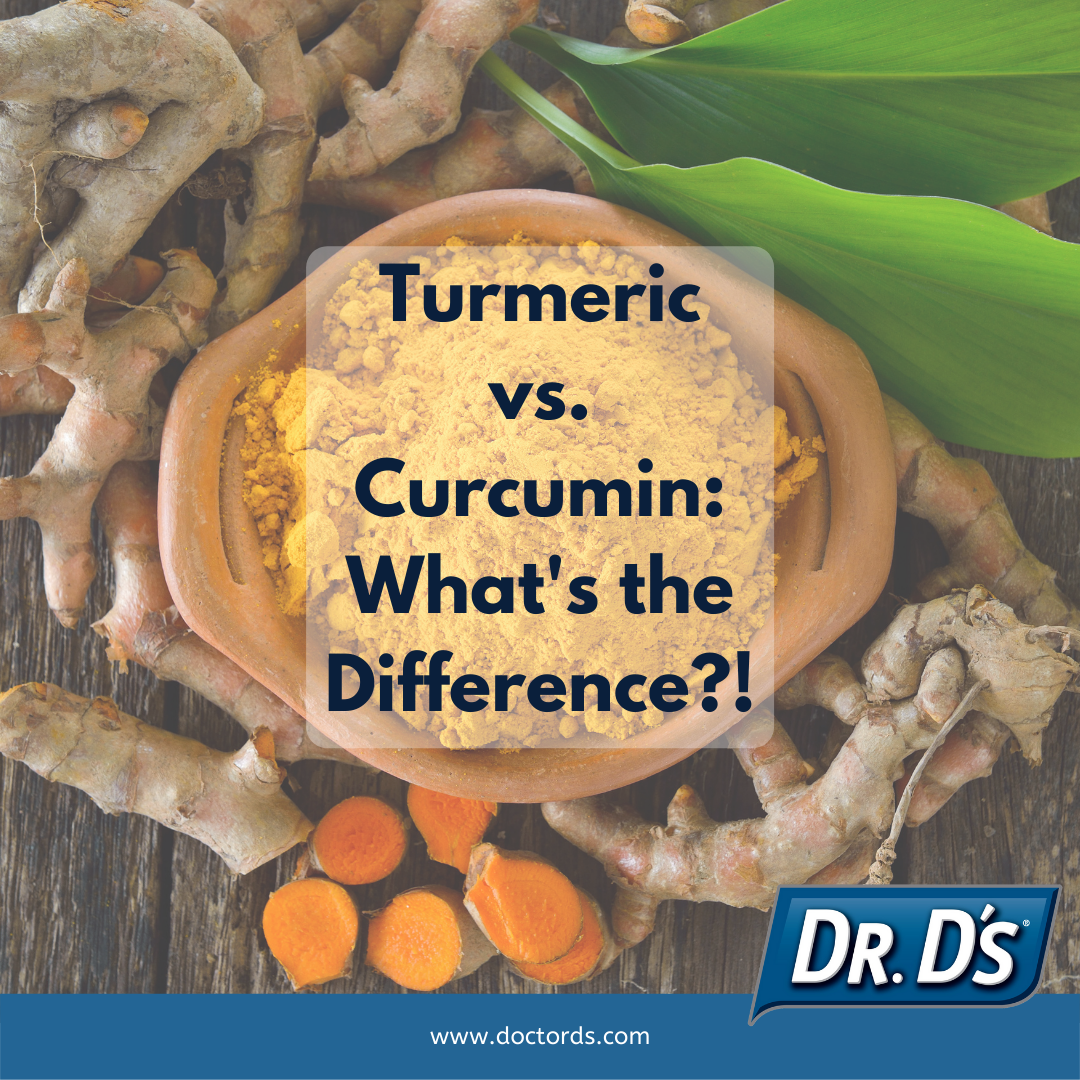
Turmeric vs. Curcumin: What's the Difference?!
Share
Turmeric is an ancient spice used in Ayurvedic medicine as a treatment for inflammatory conditions. It is one of nature’s most powerful anti-inflammatory & antioxidant!
Research shows that daily consumption can:
- Support cardiovascular health
- Support the immune system
- Support gut health
- Relieve pain associated with joint & muscle inflammation
- Have liver protective activity
- Regulate blood sugar
- Modulate PSA
- Have neuroprotective activity
Turmeric in its raw form is poorly absorbed by the gut. It would take a lot of turmeric consumption over years to optimize its extraordinary health benefits which is why it is recommended to take turmeric with high absorption in a supplement form!
Even if you know very little about turmeric, you may have heard about “curcumin,” something it is very well known for. Turmeric and curcumin are often used interchangeably and are a source of common confusion.
Turmeric is an ancient spice that comes from the Curcuma longa plant. Curcuminoids, compounds extracted from the turmeric root, are important nutrients. Curcumin is the most important curcuminoid as it contains the greatest amount of medicinal properties. Curcumin is therefore a very special component of the entire turmeric root but it is not the same thing as turmeric. Most of the research over the last 10 years have focused on just curcumin.
What most people do not know is that curcumin (although very important, yes) only comprises 3 percent of the entire turmeric root!
One of the other powerful ingredients outside of curcumin is called aromatic-turmerone (ar-turmerone, for short). This ingredient has also been shown to possess anti-inflammatory properties, but particularly in the signalling pathways of microglia.
Let’s take a step back to explain inflammation in order to really appreciate the benefits of turmeric, and its components such as ar-turmerone.
Inflammation is the immune system’s normal response to injury, toxins or infection. This short-term, or acute, inflammation is beneficial when it is under control, however, inflammation that persists longer is known as chronic inflammation. Chronic, persistent and systemic inflammation can be largely a consequence of lifestyle choices such as smoking, high intake of processed foods, high stress and environmental pollutants as these are all sources of toxins that our immune system continually tries to fight off. Chronic, persistent inflammation causes tissue destruction and scarring, reshaping of healthy or normal tissue, changes in gene expression, and much more. This maladaptive type of inflammation can be applied to any body system and is the source of all disease.
Now that you understand a little more about the immune system, let’s chat about microglia. Microglia are the immune cells of the nervous system. Picture “pacman” eating up harmful invaders. For whatever reason, as described above, something can spark chronic, persistent inflammation in the nervous system (specifically, the brain). The more maladaptive inflammation we have, the more havoc it can wreak on the carefully balanced system it is harbouring within. Microglia, for example, is a hallmark of neuroinflammation and is associated with various neurological diseases (dementia/Alzheimer’s and depression) and stroke. This means that ar-turmerone can actually stop any maladaptive inflammatory signalling cascade caused by microglia, so that they are left to function properly (ie. only target harmful invaders). Furthermore, research is showing that ar-turmerone may increase the number of neural stem cells in the brain, which play a role in the regeneration of tissue that has already been affected by neurodegenerative disease and stroke. Research has also shown that ar-turmerone has protective effects on hippocampal cells from any indirect neuronal toxicity induced by activated microglial cells. Hippocampal cells are found in the hippocampus, which is the part of the brain responsible for memory formation, and therefore associated with learning and emotion. Therefore, ar-turmerone is showing promise in offering neurological benefits in cases of brain injury and neuroprotective benefits against diseases such as Alzheimer’s and Parkinson’s.
A few other compounds include: alpha-turmerone and beta-turmerone, turmeric oil, demethoxycurcumin, 5’-methoxycurcumin, and dihydrocurcumin. These are also powerful antioxidants and have similar yet unique properties to curcumin. All of them work together synergistically for impressive medicinal results.
The whole turmeric root, and not just curcumin, is very powerful and has been used traditionally across medicinal systems for centuries. That is why we created Dr. D’s Ultra BioTurmeric to be a full-spectrum turmeric, meaning it includes much more than just curcumin!
A full-spectrum turmeric supplement means that it contains curcumin PLUS the other 200+ powerful nutrients. If you are only taking curcumin, or are on a supplement that does not state that it is full-spectrum turmeric, you may be missing out on some of the health benefits.
SOURCES:
Hewlings, S. J., & Kalman, D. S. (2017). Curcumin: A Review of Its Effects on Human Health. Foods (Basel, Switzerland), 6(10), 92. https://doi.org/10.3390/foods6100092
HUCKLENBROICH, J., KLEIN, R., NEUMAIER, B. ET AL. AROMATIC-TURMERONE INDUCES NEURAL STEM CELL PROLIFERATION IN VITRO AND IN VIVO. STEM CELL RES THER 5, 100 (2014). HTTPS://DOI.ORG/10.1186/SCRT500
PARK, S. Y., JIN, M.L., KIM, H.Y. ET AL. ANTI-INFLAMMATORY EFFECTS OF AROMATIC-TURMERONE THROUGH BLOCKING OF NF-ΚB, JNK, AND P38 MAPK SIGNALING PATHWAYS IN AMYLOID Β-STIMULATED MICROGLIA. INTERNATIONAL IMMUNOPHARMACOLOGY. 14, 1 (2012). HTTPS://WWW.SCIENCEDIRECT.COM/SCIENCE/ARTICLE/PII/S1567576912001725
JANKASEM,M. WUTHI-UDOMLERT, M., GRITSANAPAN, M. ANTIDERMATOPHYTIC PROPERTIES OF AR-TURMERONE, TURMERIC OIL, AND CURCUMA LONGA PREPARATIONS. INTERNATIONAL SCHOLARLY RESEARCH NOTICES. 2013. HTTPS://DOI.ORG/10.1155/2013/250597
HUCKLENBROICH, JOERG ET AL. “AROMATIC-TURMERONE INDUCES NEURAL STEM CELL PROLIFERATION IN VITRO AND IN VIVO.” STEM CELL RESEARCH & THERAPY VOL. 5,4 100. 26 SEP. 2014,
CHOC AND JUICE. TOP 7 MYTHS ABOUT TURMERIC DEBUNKED. 2021.
SIVER, F. THE GOODS: MYTHS AND FACTS ABOUT TURMERIC. 2016.
*THE CONTENT IN THESE BLOGS IS STRICTLY EDUCATIONAL AND NOT INTENDED TO BE A SUBSTITUTE FOR PROFESSIONAL MEDICAL ADVICE, DIAGNOSIS, OR TREATMENT. ALWAYS SEEK THE ADVICE OF YOUR PHYSICIAN OR OTHER QUALIFIED HEALTHCARE PROVIDER WITH ANY QUESTIONS YOU MAY HAVE REGARDING A MEDICAL CONDITION OR YOUR GENERAL HEALTH. ALWAYS THOROUGHLY READ AND FOLLOW INSTRUCTIONS ON THE LABELS OF YOUR SUPPLEMENTS AND/OR MEDICATIONS. NOTE THAT THE CONTENT IN THESE BLOGS MAY BECOME OUTDATED AS NEWER RESEARCH IS PUBLISHED.